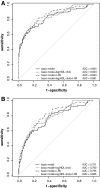First-trimester prediction of gestational diabetes mellitus: examining the potential of combining maternal characteristics and laboratory measures
- PMID: 20876721
- PMCID: PMC2992761
- DOI: 10.2337/db10-0688
First-trimester prediction of gestational diabetes mellitus: examining the potential of combining maternal characteristics and laboratory measures
Abstract
Objective: Predictors of gestational diabetes mellitus (GDM) have been widely studied, but few studies have considered multiple measures. Our objective was to integrate several potential GDM predictors with consideration to both simple and novel measures and to determine the extent to which GDM can be predicted in the first trimester.
Research design and methods: We identified first-trimester maternal samples from 124 women who developed GDM and 248 control subjects who did not. We gathered data on age, BMI, parity, race, smoking, prior GDM, family history of diabetes, and blood pressure. Using retrieved samples, we measured routine (lipids, high-sensitivity C-reactive protein, and γ-glutamyltransferase) and novel (adiponectin, E-selectin, and tissue plasminogen activator [t-PA]) parameters. We determined independent predictors from stepwise regression analyses, calculated areas under the receiver-operating characteristic curves (AUC-ROC), and integrated discrimination improvement (IDI) for relevant models.
Results: Compared with control subjects, women who subsequently developed GDM were older, had higher BMIs, were more likely to be of Asian origin, had a history of GDM or family history of type 2 diabetes, and had higher systolic blood pressure (P < 0.05 for all). With regard biochemical measures, stepwise analyses identified only elevated t-PA and low HDL cholesterol levels as significant (P ≤ 0.015) independent predictors of GDM beyond simple non-laboratory-based maternal measures. Their inclusion improved the AUC-ROC from 0.824 to 0.861 and IDI by 0.052 (0.017-0.115).
Conclusions: GDM can be usefully estimated from a mix of simple questions with potential for further improvement by specific blood measures (lipids and t-PA).
Figures

References
-
- Sattar N, Wannamethee SG, Forouhi NG: Novel biochemical risk factors for type 2 diabetes: pathogenic insights or prediction possibilities? Diabetologia 2008;51:926–940 - PubMed
-
- Enquobahrie DA, Williams MA, Qiu C, Luthy DA: Early pregnancy lipid concentrations and the risk of gestational diabetes mellitus. Diabetes Res Clin Pract 2005;70:134–142 - PubMed
-
- Lain KY, Daftary AR, Ness RB, Roberts JM: First trimester adipocytokine concentrations and risk of developing gestational diabetes later in pregnancy. Clin Endocrinol (Oxf) 2008;69:407–411 - PubMed
-
- Wolf M, Sandler L, Hsu K, Vossen-Smirnakis K, Ecker JL, Thadhani R: First-trimester C-reactive protein and subsequent gestational diabetes. Diabetes Care 2003;26:819–824 - PubMed
-
- Li S, Shin HJ, Ding EL, van Dam RM: Adiponectin levels and risk of type 2 diabetes: a systematic review and meta-analysis. JAMA 2009;302:179–188 - PubMed
Publication types
MeSH terms
LinkOut - more resources
Full Text Sources
Other Literature Sources
Research Materials

